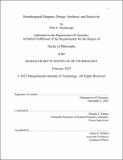Bioorthogonal Reagents: Design, Synthesis, and Reactivity
Author(s)
Abularrage, Nile S.
DownloadThesis PDF (15.87Mb)
Advisor
Raines, Ronald T.
Terms of use
Metadata
Show full item recordAbstract
The development of reactions that fit the stringent criteria for click chemistry and bioorthogonal chemistry has enabled discoveries and applications in fields ranging from materials science to chemical biology. These reactions must proceed rapidly and selectively under mild conditions. This enables the chemistry to be performed in complex systems without perturbing the normal function of the system. The prototypical bioorthogonal reactions are the copper(I) catalyzed azide–alkyne cycloaddition (CuAAC), the strain-promoted azide–alkyne cycloaddtion (SPAAC), and the tetrazine ligation. This thesis focuses on the development of new bioorthogonal reactions and reagents.
In part 1, 5-membered cyclic Diels–Alder dienes are studied. This study ranges from the development of 4H-pyrazoles as bioorthogonal reagents to an exploration of the physical organic chemistry of 5-membered cyclic dienes that accelerate or impede their reactivity in Diels–Alder reactions. I show that 4H-pyrazoles can react rapidly as Diels–Alder dienes upon the induction of hyperconjugative antiaromaticity and predistortion. These dienes can also be stabilized to biological nucleophiles allowing their use in biological systems.
In part 2, a new cyclooctyne is developed for SPAAC. This cyclooctyne, ABC, is activated by increased strain and electronic activation, and it reacts rapidly with azides and diazo compounds. This reactivity is a result of noncovalent interactions between the dipole and dipolarophile in the transition state; an n→π* interaction or a hydrogen bond. In addition to its fast reactivity, ABC can be prepared in three steps, and this work introduces a new synthetic route for the cyclooctyne scaffold.
Date issued
2023-02Department
Massachusetts Institute of Technology. Department of ChemistryPublisher
Massachusetts Institute of Technology